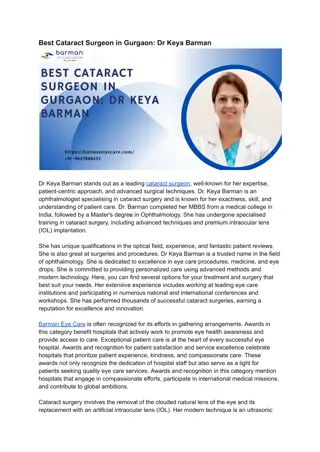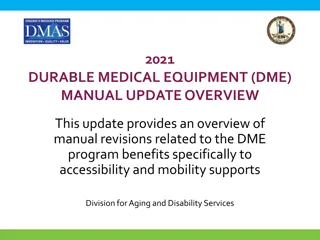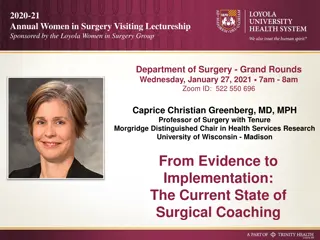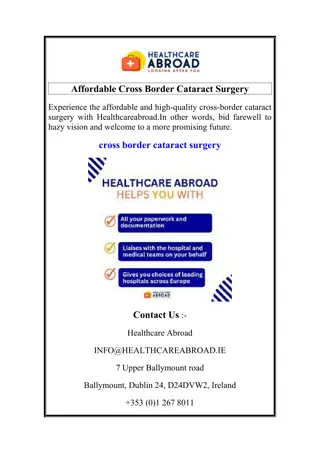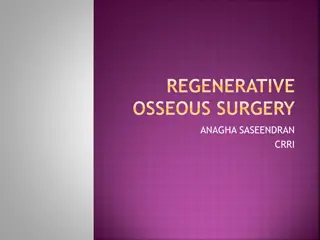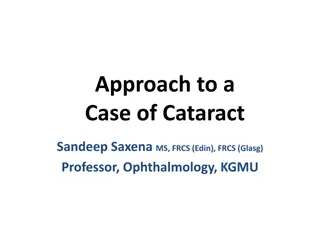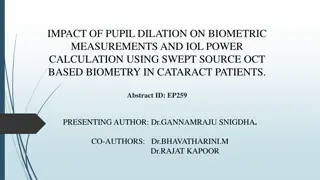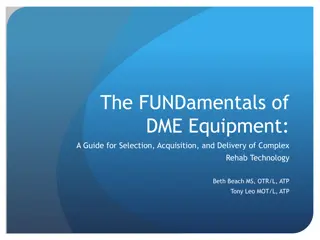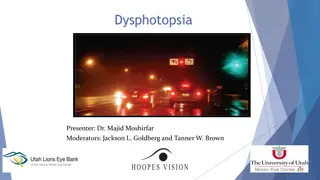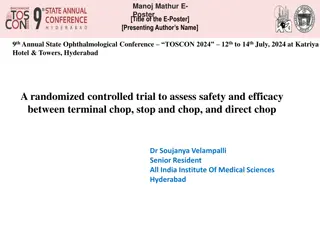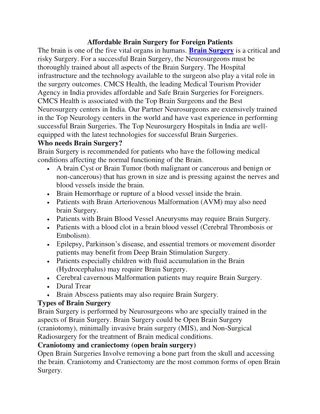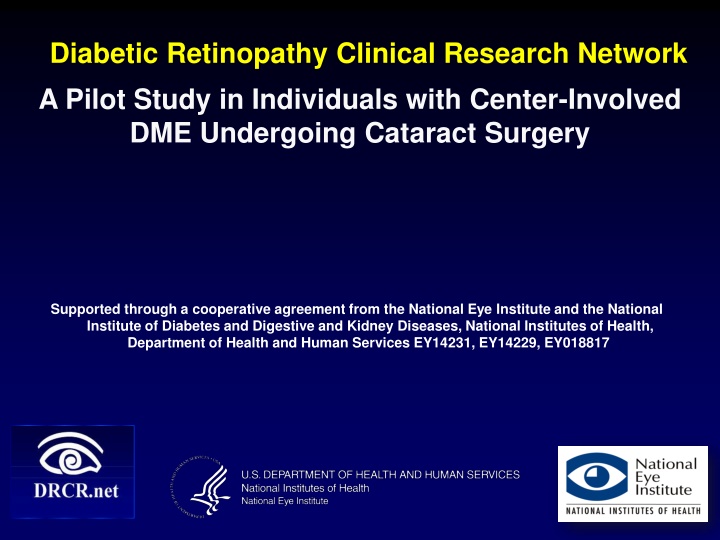
Study on Center-Involved DME in Cataract Surgery
Diabetic Retinopathy Clinical Research Network conducted a pilot study to evaluate logistical challenges and feasibility of a future randomized trial in individuals with concurrent center-involved DME undergoing cataract surgery. The study assessed recruitment potential, interactions among sites and surgeons, management of DME, and short-term DME evolution. Results showed enrollment challenges and insights for future research.
Download Presentation

Please find below an Image/Link to download the presentation.
The content on the website is provided AS IS for your information and personal use only. It may not be sold, licensed, or shared on other websites without obtaining consent from the author. If you encounter any issues during the download, it is possible that the publisher has removed the file from their server.
You are allowed to download the files provided on this website for personal or commercial use, subject to the condition that they are used lawfully. All files are the property of their respective owners.
The content on the website is provided AS IS for your information and personal use only. It may not be sold, licensed, or shared on other websites without obtaining consent from the author.
E N D
Presentation Transcript
Diabetic Retinopathy Clinical Research Network A Pilot Study in Individuals with Center-Involved DME Undergoing Cataract Surgery Supported through a cooperative agreement from the National Eye Institute and the National Institute of Diabetes and Digestive and Kidney Diseases, National Institutes of Health, Department of Health and Human Services EY14231, EY14229, EY018817 1
Background Prior to initiating a study to try to understand and improve outcomes following cataract surgery in eyes with pre-existing and concurrent DME, the DRCR.net recognized that a pilot study was needed to assess: Potential to recruit subjects Logistics/success of DRCR.net investigators interacting with cataract surgeons offices
Objectives of Pilot Study Primary Objectives: Evaluate logistical challenges of interaction among DRCR.net sites, cataract surgeons and their office personnel Determine feasibility and recruitment potential for a future randomized trial in eyes with concurrent center-involved DME and cataract for whom cataract surgery is performed 3
Objectives of Pilot Study Secondary Objectives: Describe how cataract surgeons and DRCR.net investigators managed the DME in these cases Evaluate short-term (16 weeks) evolution of DME and change in visual acuity 4
Methods Prospective Multi-center Pilot Study Principal Subject Eligibility Age 18 years Type 1 or type 2 diabetes Principal Ocular Eligibility Cataract for which surgery is scheduled within 14 days Visual acuity light perception or better OCT CSF thickness 250 m ( 310 m on Spectral Domain OCT) Surgery Performed in usual manner of surgeon Macular Edema Treatment At discretion of the surgeon and DRCR.net investigator
Results Recruitment among 29 Clinical Sites 350 300 250 Enrollment ended due to futility 200 150 100 50 0 Recruitment Goal (30 Participant/mo) 6 Actual Recruitment (7 Participants/mo)
Results: Enrollment and Follow-Up 68 Study Participants Enrolled from 29 Sites 5 Did Not Meet Eligibility Surgery not performed (N = 3) OCT CSF <250 m (310 m on Spectral Domain) (N = 2) Enrollment N = 63 Eligible 16 Week Visit N=60 (95%) completed 7
Subject Characteristics N = 63 Median age 64 yrs Gender (%) women Race (%) White Black Hispanic Asian Mutli-racial Unknown/Not Reported Diabetes type (%) Type I Type II Uncertain Median diabetes duration 46% 71% 14% 10% 2% 2% 2% 8% 84% 8% 19 yrs Insulin use (%) Yes 67% 8
Baseline Ocular Characteristics N = 63 History of DME treatment History of PRP treatment Visual Acuity ~Snellen Equivalent (median Q1,Q3) 76% 44% 20/80 (20/125, 20/50) 309 m (273 m, 348 m) Time Domain OCT CSF Thickness Median (25th, 75th percentile (N = 61) Diabetic Retinopathy Severity On Clinical Exam A. Microaneurysms only B. Mild-moderate NPDR C. Severe NPDR D. PDR and/or prior scatter 3% 35% 8% 54% 9
Cataract Surgery Data N = 60 Timing of surgery 1-14 days from enrollment Type of Procedure Phacoemulsification Extracapsular Cataract Extraction Type of Lens: PC IOL 98% 98% 2% 100% Surgical Complications Ruptured capsule Increased IOP 1 1 10
Macular Edema Treatment N = 60 None 21 (35%) Pre-operative* and Post-operative** 14 (23%) Pre-operative Only 11 (18%) 42% had Post-op Post-operative Only 10 (17%) Intra-operative (or on day of surgery) Only Pre-, Intra-, and Post-operative 3 (5%) 1 (2%) * Pre-Operative defined as any of the following: laser or intravitreal triamcinolone within 4 months, or intravitreal anti-VEGF within 2 months of the day before surgery. **Post-Operative defined as any treatment for DME performed on post-op day 1 until week 16 visit. 11
Type of Macular Edema Treatment N=60 No DME Treatment Received 21 (35%) DME Treatment Received* 39 (65%) Anti-VEGF Only 16 Laser Only 7 Anti-VEGF and Laser 6 Corticosteroid Only 4 Anti-VEGF, Corticosteroid and Laser 3 Corticosteroid and Laser 2 Anti-VEGF and Corticosteroid 1 *Include treatments received pre-, intra- and/or post-operatively 12
Type of Macular Edema Treatment N=60 No DME Treatment Received 21 (35%) DME Treatment Received* 39 (65%) Anti-VEGF Only 16 26 (43%) Anti-VEGF Laser Only 7 Anti-VEGF and Laser 6 Corticosteroid Only 4 Anti-VEGF, Corticosteroid and Laser 3 Corticosteroid and Laser 2 Anti-VEGF and Corticosteroid 1 *Include treatments received pre-, intra- and/or post-operatively 13
Visual Acuity Distribution Baseline (N=60) 16 Weeks (n=60) 20/20 or better 2% 10% 20/25 to 20/32 8% 27% 20/40 to 20/63 40% 33% 20/80 or worse 50% 30% Mean (Snellen) 20/80 20/50 14
Visual Acuity Data At 16 Weeks N = 60 Visual Acuity Change from baseline Mean Letter Score +12 32% 10% 18% 30% 10% 63% 20 Letters (4 Lines) Improve +15 to +19 Letters (3 lines) Improve +10 to +14 Letters (2 Lines) Improve +9 to -9 Letters (No Improvement) 10 Letters (2 Lines) Worsen Eyes with 20/40 or worse 15
Visual Acuity Data At 16 Weeks N = 60 Visual Acuity Change from baseline Mean Lines +2.4 32% 10% 18% 30% 10% 63% 20 Letters (4 Lines) Improve +15 to +19 Letters (3 lines) Improve +10 to +14 Letters (2 Lines) Improve +9 to -9 Letters (No Improvement) 10 Letters (2 Lines) Worsen Eyes with 20/40 or worse 16
OCT Data at 16 Weeks N = 60 CSF Thickness Change from Baseline, mean -6 m LogOCT 1 step improvement 18% LogOCT 1 step worsening 15% CSF thickness 250 m (310 on spectral domain) 88% 17
Conclusions Primary Objective As only 63 eligible eyes were recruited over 10 months Conducting a randomized trial by the DRCR.net on a similar cohort is likely not feasible due to poor enrollment totals in the pilot study Many challenges exist in coordinating activities with cataract surgeon 18
Conclusions Primary Objective Among the 63 enrolled eligible eyes Study eyes had advanced disease: 54% PDR or PRP 76% prior DME treatment Approximately half of the eyes received DME treatment during or after surgery An addition 18% received treatment only prior to surgery 19
Conclusions Secondary Outcomes Observational Study Retinal Thickness While allowing treating physicians to manage DME at their discretion, in most eyes, CSF thickness was not increased at 16 weeks post surgery Worsened 1 logOCT step 15% (95% CI 6% to 24%) 20
Conclusions Secondary Outcomes Observational Study Visual Acuity (Baseline VA median 20/80) At 16 weeks, Majority of eyes were improved: ~1/3 of the eyes were 20/32 or better 60% improved 10 letters However, unlike cataract surgery among eyes WITHOUT macular pathology, many did not have improvement after surgery and some substantially worsened. 30% (95% CI 19% to 43%) did not improve 2 lines 10% (95% CI 2% to 18%) worsened 2 lines 21
Conclusions Secondary Outcomes Cataract Surgery with Concurrent DME Due to lack of standardization of DME management: conclusions regarding effect of DME treatment on VA or retinal thickness outcomes cannot be made 22
Conclusions Secondary Outcomes Cataract Surgery with Concurrent DME When pre-, intra-, and post-op management of central-involved DME was at investigator discretion, in a cohort with advanced DR, at 16 weeks post-operatively: Worsening in thickness occurred in minority (15%) Average Visual Acuity change was positive (+12 letters) Although, 1/3 did not improve by at least 2 lines and 10% lost 2 or more lines 23
Conclusions Secondary Outcomes Cataract Surgery with Concurrent DME Thickness findings are relatively reassuring, although 15% of eyes had a worsening of DME, based on OCT through 16 wks post-operative Visual Acuity results were less favorable than what is expected in a cohort without macular edema or without DR oCannot assess the impact that concurrent macular edema had on the true vision potential in this cohort oIt remains unknown if outcomes might have been better with more aggressive DME management (pre, intra, or post-op) 24










